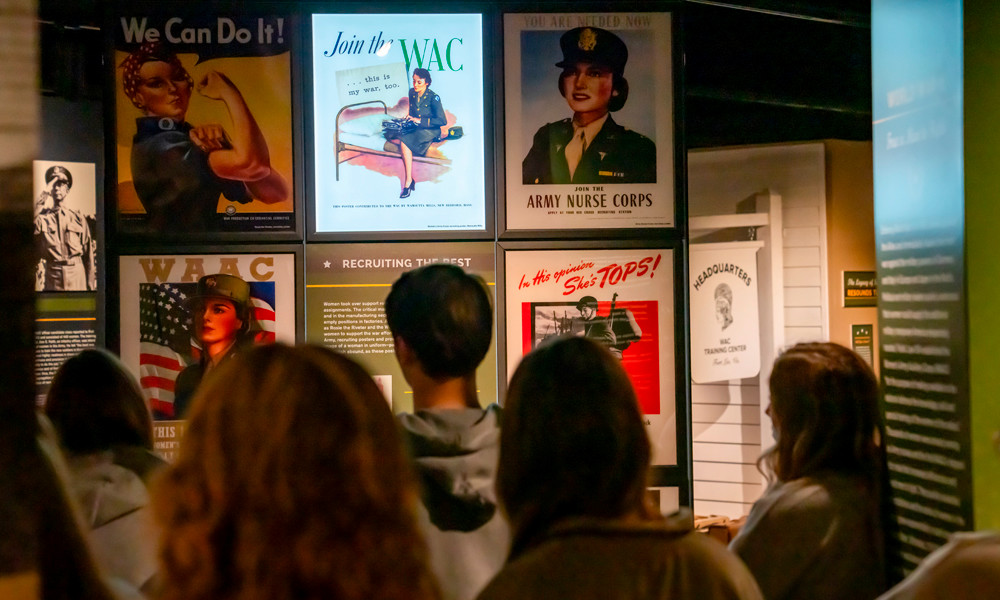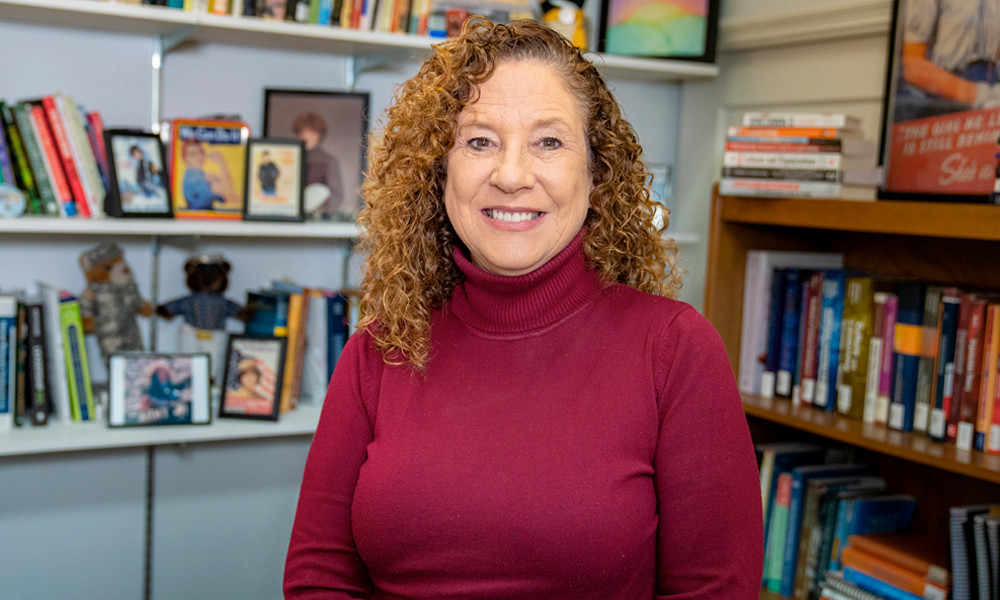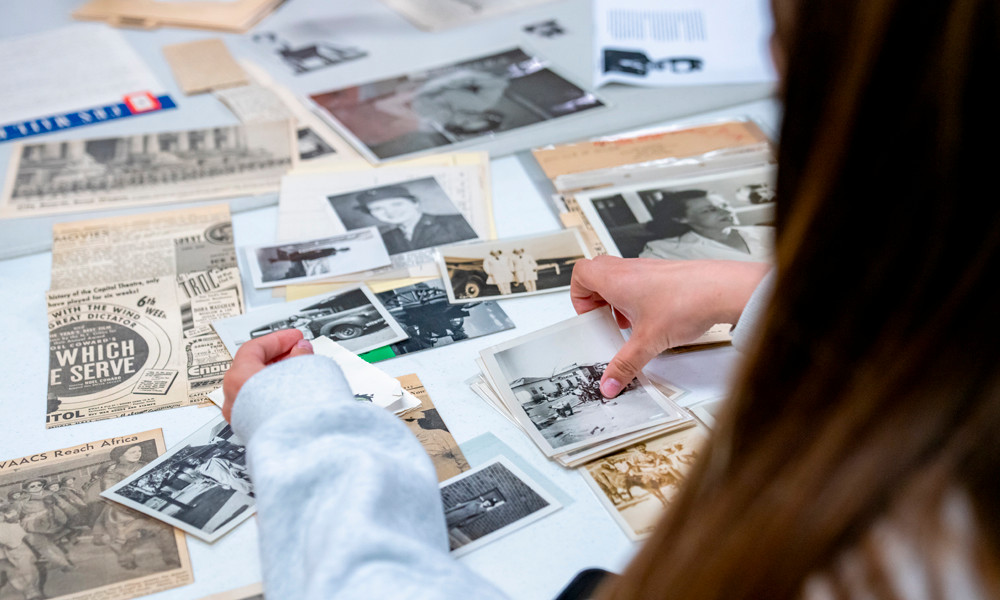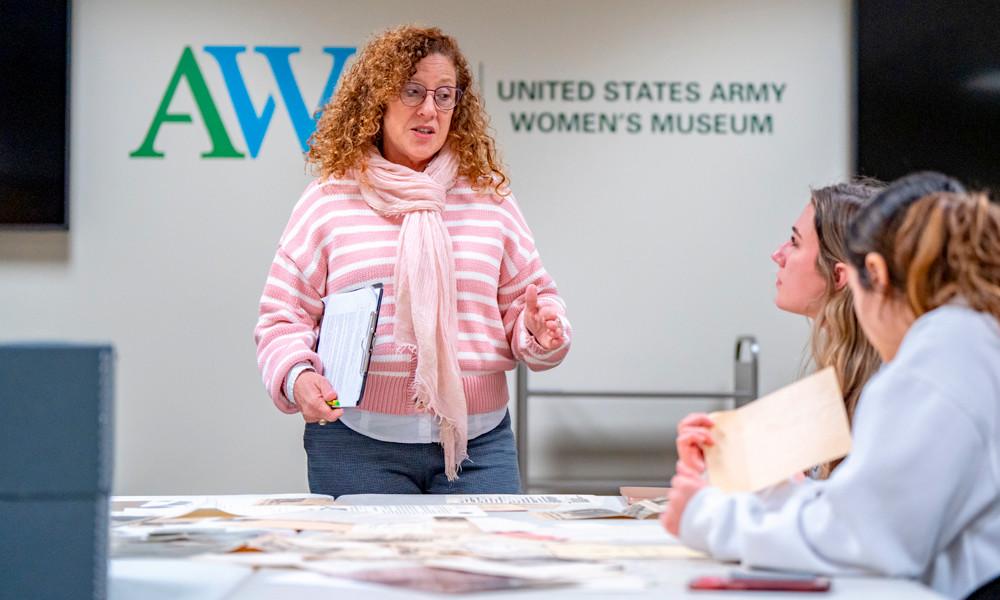Army veteran keeps women’s military contributions alive
News
SUMMARY: Amelia Underwood (’13M), an instructor in the Department of Learning, Technology and Leadership Education, teaches classes on leadership and American military history as well as an Honors course, American Women at War. Students in the course gain hands-on experience with handling, archiving and preserving primary-source materials at the Army Women’s Museum at Fort Lee, Virginia (now Fort Gregg-Adams).
Near the end of the Cold War, Lt. Amelia Underwood (’13M) was a field artillery officer assigned to Lance Missile battalions at Fort Sill, Oklahoma. The tactical, surface-to-surface nuclear missile was an important part of the Army’s ground arsenal. It could be launched from the back of a vehicle and used to take out mid-range, enemy targets such as airfields, command centers and supply routes.
“Its signature was so great … it would cause a grid-square worth of nuclear destruction — very daunting,” Underwood said. “I remember thinking, ‘I’m 23 years old, and I’m responsible for launching a nuclear weapon.’ The gravity of that was tremendous.”
At the same time, she said, “I was very excited because, as a woman, to serve in a combat arms branch gave you more of an equal status with men. I thought to myself, ‘This is my opportunity.’”
That opportunity ended abruptly in 1994 when Secretary of Defense Les Aspin drafted a memo excluding women from serving in direct combat units on the ground.
 |
|
“Military service is a vital component of protecting our nation. Not everyone wants to serve but many do. And they should have that opportunity. It shouldn’t matter that you’re a woman. If you have the capability and you have the desire, you should do it. And you should be valued and respected and accepted for that contribution, and not stigmatized because you’re different.” — Amelia Underwood (’13M), instructor, Army historian |
Underwood, a 1987 graduate of the United States Military Academy at West Point and a member of the academy’s eighth class of women, was highly respected by her fellow officers, subordinates and staff, and was preparing to enter the Army Command and General Staff College to improve her chances at promotion when the order was handed down. “They told all women who were in field artillery, ‘You must branch transfer.’ And I didn’t have a real set of mentors who could guide me through that space to say, ‘You still have a very viable career. Let’s look at opportunities for you.’”
Underwood didn’t want to leave the Army. “I loved working with my soldiers,” she said. “People trusted me. I trusted them. I felt like what we were doing was making a difference.” But as an Environmental Studies major with leadership experience, she was being heavily recruited by big corporations with the lure of big money. Rather than accept a transfer, she decided to give up her military career to take a job with Mobil Oil Corp.
In 2006, Underwood attended a conference commemorating 30 years of women at West Point. The gathering featured women from the first co-ed class of cadets to the present day. “There was this sense of many of us coming to terms with our experience there,” she said. “I wanted to understand what was it about the lived experience of both women and men at this period of time, how they understood themselves to be cadets and warriors, and why there was so much resistance to women sharing that space with men.”
In 2010, Underwood enrolled in graduate school at JMU. She supplemented her coursework in U.S. history with classes in anthropology and psychology, and she accepted a fellowship to the Air Force Academy to research its first decade of gender integration. Following the passage of a law in October 1975 permitting women to be admitted to the nation’s military academies, the Air Force Academy had begun preparing for their arrival. But there were underlying concerns about women who served in the military becoming more independent and less feminine. One of the primary considerations at the Air Force Academy was what uniforms they should wear. “Most of the initial mockups looked like a stewardess with go-go boots,” Underwood said. The academy also chose to segregate its early classes of female recruits, a fact Underwood believes hurt their chances of being fully accepted by their male counterparts.
After completing her master’s degree in 2013, Underwood became director of leadership development and academic affairs at the Virginia Women’s Institute for Leadership, the nation’s only all-female Corps of Cadets, at Mary Baldwin University in Staunton, Virginia. She continued to serve as an adjunct professor at JMU, teaching courses on leadership, American military history and, beginning in 2015, American Women at War.
 |
The course examines the role of women in the U.S. during wartime, from the American Revolution to the wars in Iraq and Afghanistan. In addition to looking at how women who serve in the military become agents for change in American society, students in the course gain hands-on experience with handling, archiving and preserving primary-source materials at the Army Women’s Museum at Fort Lee, Virginia (now Fort Gregg-Adams). Students then create a product that brings to life the previously unknown stories of women who served in the Army in World War I and World War II.
Underwood recalls sitting in a graduate class at JMU in 2013 when she learned that the last restriction on women in direct, ground-combat roles had been lifted.
“Military service is a vital component of protecting our nation,” she said. “Not everyone wants to serve but many do. And they should have that opportunity. It shouldn’t matter that you’re a woman. If you have the capability and you have the desire, you should do it. And you should be valued and respected and accepted for that contribution, and not stigmatized because you’re different.”
Underwood earned a doctorate in organizational leadership and human-resource development in 2023. She teaches in the Department of Learning, Technology and Leadership Education at JMU and serves as a mentor and role model for female Army ROTC cadets. She is the founder and chair of the JMU Women’s Military Forum and serves on the President’s Task Force for Veterans Affairs.


